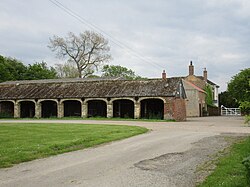Watton, Yorkshire
| Watton | |
| Yorkshire East Riding | |
|---|---|
 Watton Grange Farm | |
| Location | |
| Grid reference: | TA016501 |
| Location: | 53°56’15"N, 0°27’13"W |
| Data | |
| Population: | 259 (2011) |
| Post town: | Driffield |
| Postcode: | YO25 |
| Dialling code: | 01377 |
| Local Government | |
| Council: | East Riding of Yorkshire |
| Parliamentary constituency: |
East Yorkshire |
Watton is a village in the East Riding of Yorkshire. The village is on the A164 road, about six miles north of Beverley and six miles south of Driffield.
The 2011 census recorded a parish population of 259.
History
In the 6th century Watton according to legend, a Frankish saint, Monegunda of Watton,lived here.[1] In the 13th century it was the home of to William de Malton, master-mason who built Beverley Minster[2] was buried here.
The Venerable Bede in his Ecclesiastical History of the English People tells of a miracle of Saint John of Beverley that took place in Watton. It is also the setting for the 12th-century miracle story De Sanctimoniali de Wattun.

Watton is the location for Watton Priory which was a Gilbertine double monastery founded in 1150 by Eustace fitz John.[3] One legend of the priory is that of The Nun of Watton, famous from Ailred of Rievaulx's De Sanctimoniali de Wattun, noted for her pregnancy while in the priory. The priory was dissolved in 1539 by Henry VIII.
The present building dates mainly from the 14th and 15th centuries, although it has earlier origins, and a house was added in the 19th century. It is a Grade I listed building.[4][5]
Near to the priory is the Church of St Mary which is a Grade I listed building.[6] The church building is primarily of 15th century construction but some 13th century materials remain, while the south porch, and north vestry are dated 1859. The parapet to tower is 20th century.
Name
The origin of the word Watton is uncertain, but suggestions include[7][8] the Old English wad tun (‘woad farmstead’), or waden (ford), or wætan (‘watery’).
Outside links
| ("Wikimedia Commons" has material about Watton, Yorkshire) |
- Watton, Yorkshire in the Domesday Book
References
- ↑ Farmer, David (2011). The Oxford Dictionary of Saints. Oxford University Press.
- ↑ Malton, William de. A Dictionary of Architecture and Landscape Architecture. Oxford University Press.
- ↑ "Forbidden love in Watton". Where I Live - Humber. BBC. 9 January 2006. https://www.bbc.co.uk/humber/content/articles/2006/01/09/history_watton_forbidden_love_feature.shtml. Retrieved 27 August 2010.
- ↑ National Heritage List 1161550: Watton Abbey (Grade I listing)
- ↑ National Heritage List 1161550: Watton Abbey (Historic England)
- ↑ National Heritage List 1083772: Church of St Mary (Grade I listing)
- ↑ Place-Names
- ↑ Ekwall, Eilert, The Concise Oxford Dictionary of English Place-Names. Oxford, Oxford University Press, 4th edition, 1960. p. 501 ISBN 0198691033
- Gazetteer — A–Z of Towns Villages and Hamlets. East Riding of Yorkshire Council. 2006. p. 11.
